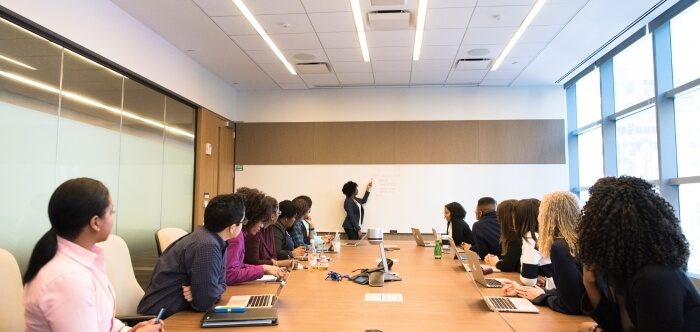Setting up a conference room might seem straightforward, but meetings can become tedious and inefficient when it’s not equipped with the right tools. Have you ever sat in a room struggling with poor connectivity or facing a blank screen due to technical glitches? This leads us to ask, “What should be in a conference room?”
A functional meeting space demands more than just a table and chairs. It should have reliable Wi-Fi, a Smart Board or projection screen, and high-quality audio equipment. But that’s not all. Embracing digital projectors and video conferencing tools can significantly elevate your presentations, promoting effective global collaborations.
And for those marathon meetings? Ensure there’s an accessible breakroom nearby for that much-needed break. Dive into this guide to discover the essentials of a conference room that genuinely delivers.
What is the General Use of a Conference Room?
Modern businesses view conference rooms as more than just spaces to gather. They represent collaboration hubs where innovation sparks. Their design and purpose have evolved over time.
Often, the primary purpose of these spaces is to facilitate group discussions. Whether brainstorming, decision-making, or problem-solving, a conference room provides a dedicated area where teams converge their thoughts and energy. This environment promotes focus, minimizes distractions, and fosters collective thinking. However, you need to have a vast knowledge of the conference room requirements in order to get the full out of it.

Additionally, with technological advancements, these rooms serve as global connection points. Video conferencing tools within these spaces allow businesses to bridge geographical gaps, bringing together stakeholders worldwide. This technology-driven collaboration ensures seamless communication and efficient operations.
Lastly, conference rooms play a role in external communications. Hosting client meetings, investor pitches, or interviews, they offer a professional setting that reflects a company’s brand and ethos. A well-equipped room can leave lasting impressions, influencing business outcomes in subtle yet impactful ways.
Different Types of Conference Rooms
Conference rooms have evolved from simple spaces to specialized environments tailored to distinct needs. Each type serves a unique purpose, reflecting the multifaceted nature of modern businesses. These specialized rooms drive efficiency, enhance communication and foster innovation.
Boardroom Style
Boardroom-style conference rooms are designed for high-level discussions and decision-making. They typically feature a large, central table and offer an atmosphere of authority. Ideal for executive meetings, they promote focus and formality.
Huddle Rooms
Huddle rooms are small, intimate spaces meant for quick discussions or impromptu team meetings. They encourage spontaneity, allowing for rapid idea exchange and collaboration without reservations. Informality reigns, making them popular in dynamic workspaces.
Training Rooms
Training rooms cater specifically to educational sessions or workshops. Their layout supports learning, often featuring tech tools like intelligent boards or projectors. Interactive and functional, they enable skill development and information dissemination.
Teleconferencing Rooms
The audio-visual equipment in teleconferencing rooms is designed for virtual collaboration. They connect teams across distances, breaking geographical barriers. With top-notch tech, they ensure smooth and clear global communication.
Auditorium Style
When addressing large audiences, auditorium-style rooms come into play. They’re spacious with tiered seating, designed for presentations or seminars. Their layout prioritizes visibility and audibility for every participant. Whatever style you choose for the event, never forget to choosing a conference style chair for each participant.
In a constantly evolving business landscape, the importance of tailored conference spaces cannot be overstated. Choosing the right environment can influence outcomes, shape discussions, and pave the way for successful collaborations. When next you step into one, consider its design purpose and how it complements the meeting’s objectives.
What Should Be in a Conference Room?
Conference rooms play a pivotal role in facilitating communication and collaboration within businesses. To maximize their effectiveness, they must be equipped with certain essentials. But what should be in a conference room? Here are some of the essential items crucial for a well-functioning conference room:
Reliable Wi-Fi Connection
In today’s digital age, a robust Wi-Fi connection is the backbone of any meeting. It supports everything from file sharing to video conferencing, enabling real-time collaboration. Unreliable internet can stall meetings, making a robust Wi-Fi setup critical.
High-Quality Audio Equipment
Poor audio quality can lead to misunderstandings and loss of crucial information. Therefore, if needed, invest in professional-grade microphones, speakers, and even an audio mixer. This will ensure that all participants can clearly hear and be heard.
Interactive Smart Board or Projection Screen
Simply put, your presentation’s impact depends on how well it is displayed. An interactive Smart Board or a high-definition projection screen enables more engaging and interactive presentations, which can elevate the overall meeting experience.
Latest Digital Projector
A complementary tool to your projection screen, a digital projector defines how your visuals will look to the audience. Opt for a high-definition, reliable model that can project clear, sharp images and videos to keep attendees engaged.
Ergonomically-Designed Comfortable Seating
Participants are more likely to stay focused when they are comfortable. Ergonomically designed chairs offer comfort and reduce the risk of physical strain during long discussions, thus maintaining focus and energy levels.
Advanced Video Conferencing Tools
In an interconnected global landscape, video conferencing tools are no longer optional. A high-quality camera and specialized software ensure you can connect seamlessly with remote participants, making real-time collaboration possible regardless of distance.
Functional Whiteboards and Varied Markers
Remember to underestimate the power of a good old whiteboard. It’s a perfect addition to decorate a conference room for jotting down quick ideas, drawing charts, or getting team members’ feedback. Ensure you have multiple marker colors for better clarity and organization.
Efficient Climate Control Systems
The room’s temperature can significantly impact the concentration levels of the participants. An efficient climate control system, including both heating and cooling options, can maintain a conducive environment for productive discussions.
Ample Power Outlets and Charging Stations
In today’s tech-savvy world, there needs to be more charging options. Strategically placed power outlets and dedicated charging stations ensure everyone’s devices remain operational throughout the meeting.
Accessible Breakroom with Amenities
An accessible breakroom, stocked with beverages and snacks, can provide much-needed respite during marathon meetings. Short breaks to such a space can invigorate the team, making the discussions more productive when reconvened.
To sum it up, the efficacy of a conference room lies in its details. From advanced tech amenities to simple comfort provisions, each element plays a unique role in ensuring meetings are as productive as they can be. Make sure your conference room checks all these boxes to optimize its utility.
Benefits of Having a Well-Equipped Conference Room
A well-equipped conference room can be a game-changer for any business, impacting the meetings and the company’s overall productivity. The right tools and amenities make this space a hub for innovation and effective communication. Let’s delve into the advantages of having a well-stocked meeting space.
Enhanced Collaboration
Good-quality video and audio equipment facilitate smoother interaction among team members. Clear communication channels can transform a mundane meeting into an energetic brainstorming session. Ultimately, this level of engagement encourages creative problem-solving.
Optimized Productivity
With a focus on comfort, ergonomically designed furniture can drastically improve attendees’ attention spans. When participants are comfortable, they are more likely to contribute positively. Advanced tech tools also streamline tasks, thereby maximizing meeting output.
Better Remote Involvement
High-quality video conferencing tools offer the remote workforce a more engaging experience. Through advanced technology, distance becomes irrelevant as teams collaborate in real time. The sense of presence fosters a more cohesive work environment.
Enhanced Presentation Capabilities
Digital projectors and interactive smart boards make data visualization simpler and more compelling. A strong presentation can influence opinions and drive home key points. These tools allow presenters to offer more prosperous, more nuanced narratives.
Robust Connectivity
In an interconnected world, a steady Wi-Fi connection is indispensable. It facilitates easy access to cloud services, seamless data transfer, and instant global communication. This form of constant connectivity enhances workflow and decision-making.
Increased Professionalism
A well-equipped room speaks volumes about a company’s professionalism. It sends a positive message to clients, investors, and employees alike. High standards in the meeting environment can positively influence external business relationships.
Employee Satisfaction
Comfortable seating, climate control, and a refreshment breakroom create a pleasant atmosphere. A well-designed space shows employees that their well-being is a priority. Job satisfaction often translates into enhanced performance and loyalty.
Investing in a well-equipped conference room offers numerous tangible and intangible benefits. It creates an ecosystem that encourages collaboration, boosts productivity, and adds a layer of professionalism that can set your business apart. Every detail, from furniture to tech, creates a conducive environment for successful business operations.
Frequently Asked Questions
How do I make my conference room look professional?
A professional conference room is a reflection of your business. To create a welcoming and impressive space, focus on cleanliness, organization, and thoughtful decor. Keep the room clutter-free, ensure chairs and tables are arranged neatly, and add a touch of personality with plants, artwork, or company branding. Remember, a well-maintained conference room can leave a lasting impression on clients and colleagues.
What is a conference room layout?
A conference room layout is like the blueprint for your meetings. It’s how you arrange the furniture and space to facilitate effective communication and collaboration. A well-planned layout ensures everyone feels comfortable, engaged, and able to participate fully. Think of it as setting the stage for successful discussions and decisions.
What does every conference room need?
Every conference room needs a few essential elements to function effectively. A comfortable seating arrangement, a large table for note-taking and collaboration, proper lighting, and adequate ventilation are must-haves. Don’t forget about technology like a projector, whiteboard, and sound system to enhance presentations and discussions. A touch of personality with plants or artwork can also create a more inviting atmosphere.
What should a conference include?
A successful conference is more than just a meeting. It’s an opportunity to share knowledge, network, and inspire. To make it memorable, include a mix of presentations, workshops, panel discussions, and networking events. Don’t forget to provide plenty of breaks for attendees to recharge and connect with others. A well-organized conference will leave everyone feeling informed, motivated, and ready to take on new challenges.
What should be on a conference checklist?
A conference checklist is your roadmap to success. It should include everything from venue selection and speaker coordination to catering and technology setup. Don’t forget to consider attendee registration, marketing, and on-site logistics like signage and parking. A comprehensive checklist will help you stay organized and ensure a smooth-running event.
Final Considerations
Navigating the corporate world, one often overlooks the importance of a thoughtfully designed conference room. However, its significance must be considered. As businesses pivot to more collaborative and tech-driven operations, the question of “what should be in a conference room?” becomes paramount.
Beyond the apparent table and chairs, these rooms need to be technological powerhouses, fostering communication across distances, offering clear visuals for presentations, and ensuring attendee’s comfort. These rooms’ evolution mirrors modern businesses’ dynamic nature, emphasizing connectivity, professionalism, and employee well-being.
Investing in a well-equipped conference space optimizes internal interactions and amplifies the company’s external image, making it a key component of successful business infrastructures.





